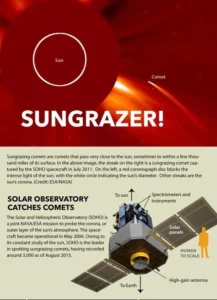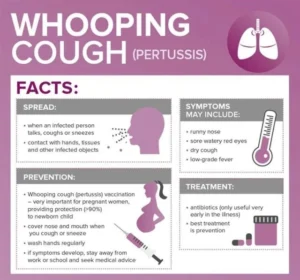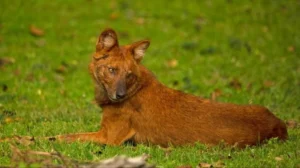Sungrazing Comets
News: A tiny sungrazer comet named SOHO-5008 was discovered, photographed, and then destroyed within a span of 24 hours during a recent total solar eclipse in North America.
Comet:
- Comets are large objects made of dust and ice that orbit the Sun.
- These ancient objects are leftovers from the formation of the solar system 4.6 billion years ago.
- They have long and streaming tails.

Sungrazer:
- Sungrazing comets are a special class of comets that come very close to the sun at their nearest approach, a point called perihelion.
- To be considered a sungrazer, a comet needs to get within about 850,000 miles from the sun at perihelion.
- Many come even closer, even to within a few thousand miles.
- Being so close to the sun is very hard on comets for many reasons.
-
-
- They are subjected to a lot of solar radiation which boils off their water.
- The physical push of the radiation and the solar wind also helps form the tails.
- As they get closer to the sun, the comets experience extremely strong tidal forces, or gravitational stress.
- In this hostile environment, many sungrazers do not survive their trip around the sun.
- Although they don’t actually crash into the solar surface, the sun is able to destroy them anyway.
- Many sungrazing comets follow a similar orbit, called the Kreutz Path, and collectively belong to a population called the Kreutz Group.
-
-
Kreutz Comets:
- They are fragments from a single large comet that was shattered thousands of years ago, when it got close to the Sun, the ice binding it together evaporated.
- The far end of the Kreutz path lies 160 times farther from the sun than the orbit of Earth.
Science Based Targets Initiative (SBTi)
News: Climate target organisation SBTi faces backlash over carbon-offsetting plan.
Introduction: The Science Based Targets Initiative (SBTi) is a global initiative set up in 2015.
Aim: To encourage and support companies to set science-based targets (SBTs):
-
-
- to reduce greenhouse gas emissions and
- limit global warming to well below 2°C above pre-industrial levels.
-
Partnership: SBTi is a collaboration between CDP, the United Nations Global Compact, World Resources Institute (WRI), and the World Wide Fund for Nature (WWF).
Framework and Verification Process: The SBTi provides a framework and guidelines for companies to set targets that are in line with the latest climate science, including the goals of the Paris Agreement.
-
-
- This involves setting targets that are consistent with limiting warming to 1.5 °C above pre-industrial levels.
-
Targets: The SBTi distinguishes between near- and long-term goals and commitments.
-
-
- Near-term targets: Show how organizations intend to reduce emissions over the next 5-10 years, crucial for significant progress by 2030 and a prerequisite for net zero targets.
- Long-term targets: Indicate how organizations need to reduce their emissions to achieve net zero, according to the criteria of the SBTi Corporate Net-Zero Standard, by 2050 at the latest (2040 for the energy sector).
-
Importance:
- It is the world’s only framework for corporate net-zero target setting in line with climate science.
- It provides the guidance & tools companies need to set science-based net-zero targets.
Global Trade Outlook and Statistics
News: Recently, the WTO published the 2024 edition of the “Global Trade Outlook and Statistics” report.
Global Trade Outlook and Statistics:
- It is published by World Trade Organization.
- The report analyses recent global trade developments.
Key Findings:
World Merchandise Trade Volume Projection: The projected growth for world merchandise trade volume indicates a 1.7% increase in 2023, followed by a further uptick to 3.2% in 2024.
Risk Factors: The forecast is accompanied by downside risks, including geopolitical tensions, food insecurity, potential financial instability due to monetary policy tightening, and escalating levels of debt.
-
- The Israel-Palestinian conflict, particularly involving Hamas, could disrupt trade significantly, especially if it affects energy markets.
2022 Trade Performance: In 2022, trade volume growth was slower than anticipated, standing at 2.7%, largely due to a fourth-quarter slump. Despite this, it outperformed worst-case scenarios initially envisioned at the onset of the conflict in Ukraine.
Value of World Merchandise Trade: The value of world merchandise trade surged by 12% to reach US$ 25.3 trillion in 2022, with elevated global commodity prices contributing to this increase.
Commercial Services Trade: World commercial services trade saw a notable rise of 15% in 2022, amounting to US$ 6.8 trillion. Additionally, digitally delivered services exports reached US$ 3.82 trillion during the same period.
Performance of India:
- Goods Export Performance: India recorded goods exports of $451 billion in FY 23 and $394.99 billion in April-February FY24, showcasing a robust export performance.
- Global Goods Exports Share: India held a 1.8% share of global goods exports in 2023 and a 2.8% share of imports during the same period.
- Digital Services Growth: India’s share of digitally delivered services rose from 4.4% in 2019 to 6% in 2023, indicating significant growth in this sector.
- Commercial Services Exports and Imports: In global commercial services, India’s share in exports reached 4.4% in 2023, totaling $344 billion and marking an 11% increase from the previous year.
-
-
- Import levels remained flat at $247 billion during the same period.
-
-
World Trade Organization (WTO):
- The World Trade Organization is an intergovernmental organization.
- It regulates and facilitates international trade.
- WTO came into operation in 1995, following the 1994 Marrakesh Agreement.
- WTO replaced the General Agreement on Tariffs and Trade (GATT) that had been established in 1948.
- WTO with 164 member states represents over 98% of global trade and global GDP.
- Headquarters: Geneva, Switzerland.
Whooping Cough
News: Whooping cough outbreak in China, US, UK and other countries has raised alarm bells.
Whooping Cough:
- Whooping cough (pertussis) is a highly contagious respiratory tract infection.
- In many people, it’s marked by a severe hacking cough followed by a high-pitched intake of breath that sounds like “whoop.”
Symptoms:
-
- Runny nose
- Mild fever
- Mild, occasional cough
- Fits of many, rapid coughs followed by a high-pitched “whoop” sound
- Vomiting during or after coughing fits
- Exhaustion after coughing fits

Causes:
- Whooping cough is caused by a type of bacteria called Bordetella pertussis.
- It spreads from person to person.
- It spreads through coughing, sneezing, or breathing very close to someone.
- It can also sometimes be spread by touching an infected surface and then touching your nose or mouth.
Treatment – Diphtheria, tetanus and pertussis (DTaP) vaccines
Asiatic Wild Dogs (Cuon alpinus)
News: Two Asiatic wild dogs (Cuon alpinus) rescued in Mumbai.
Definition: Asiatic Wild Dog is a wild canid found in the forests of central, south, and southeast Asia.
-
- It is also called as Indian wild dog, whistling dog, red wolf, red dog and mountain wolf.

Canid: A canid is a mammal in the biological family Canidae. This family includes foxes, wolves, dogs, coyotes, jackals, and more.
Distribution:
- Asiatic Wild Dogs are found throughout Eastern and Southeastern Asia.
- They can be seen as far north as Siberia, as far south as some Malaysian islands, and as far west as the Indian peninsula.
- They are found in three clusters across India, namely the Western and Eastern Ghats, the central Indian landscape and North East India.
Features:
- Its length ranges between 76 and 100 cm (30 and 40 inches), exclusive of the 28–48-centimetre (11–19-inch) tail, and its weight is from 14 to 21 kg.
- They vary in color from charcoal gray to rust red to sandy beige, depending on their habitat.
- Their tail is brushy and fox-like, often with a black tip.
- They do have lighter coloration along their chest, belly, and paws.
- Dholes are highly social animals, and they frequently hunt in packs of 5 to 12.
Conservation status:
- IUCN Red List: Endangered
- The Wildlife Protection Act 1972: Schedule II
- CITES: Appendix II
Manga Disease
News: Mange outbreak reported among Asiatic wild dogs in Mudumalai.
Definition and Characteristics: Mange is a skin disease in animals, marked by inflammation, itching, skin thickening, and hair loss. It can manifest in various severity levels.
Cause and Severity: The most severe form of mange is caused by strains of the mite Sarcoptes scabiei, also responsible for human scabies.
Transmission Methods: Mange mites are transmitted among animals through direct contact and via objects that have been in contact with infected animals.
Treatment and Manageability: Fortunately, most forms of mange are treatable, offering hope for affected animals’ recovery.

